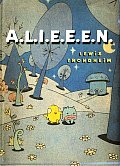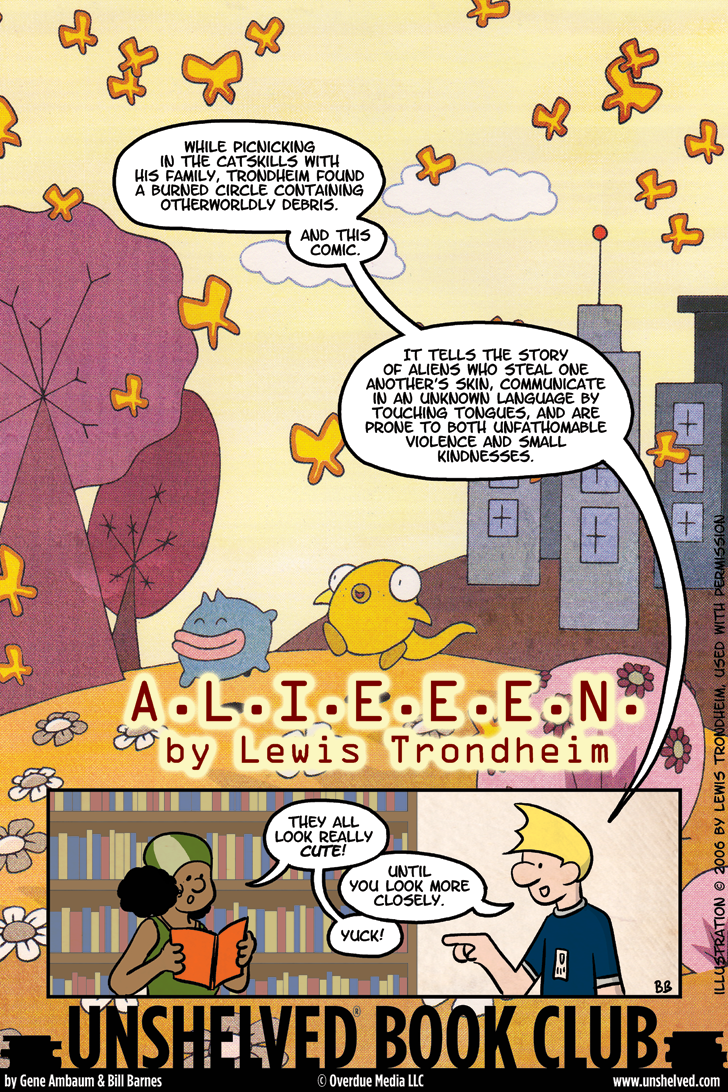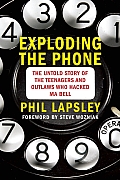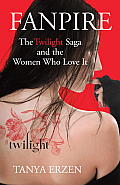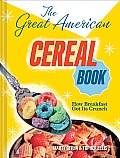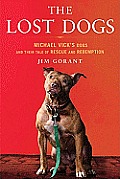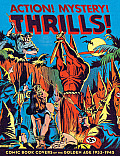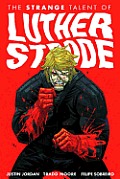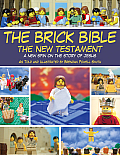Link to this review in the form of a comic strip by geneambaum tagged science fiction • graphic novel
Link to this review by flemtastic tagged nonfiction
Ever since an Esquire article in 1971 coined the term phreaking for the practice of abusing the phone company protocols to make free and untraceable phone calls, myths have abounded about what tech hackers could and couldn’t do. Phil Lapsley sets the record straight with a well-researched book that shows, among other things, that the small plastic bosun’s whistle that came free in a box of Captain Crunch cereal could, if one air hole was blocked, play a tone at 2600 cycles per second, making it the perfect tool for giving instructions to AT&T phones. Most phreaks were intensely interested in how the complex phone system was set up by Bell Labs, who put out all the information in dense technical journals that could be found at research libraries. Armed with this information, hackers played with sounds until they could do whatever they wanted to the system.
Phone companies finally began to notice anomalies, like hundreds of untraceable calls to obscure, unlisted numbers that were normally used for testing circuits. Lapsley recounts how AT&T used an illegal call-tracing and taping system to record the conversations of thousands of callers, attempting to find the culprits.
In addition to a wealth of technical information recounted in layman’s terms, Lapsley also humanizes the phreakers by telling their stories. Joe Engressia, often considered the granddaddy of the group, was a blind kid who loved phone sounds. He often sat with his back to the wall, dialing random numbers for hours and listening to the tones the phone made. Abbie Hoffman, the well-known student-activist Yippie leader, even printed instructions for phreaking in his newsletter, hoping to teach others how to stick it to the man.
A fascinating review of the now defunct practice of phreaking (new, digital systems have made the musical tones obsolete).
Why I picked it up: I was a teen when this was all happening. I remember rumors of being able to make free calls using a whistle.
Why I finished it: We owe our iPhones and iPads to phreaking. Steve Jobs and Steve Wozniak got their start making “blue boxes,” handmade tone-generators that their college friends and Hollywood connections used to make free calls. Jobs said, “If we hadn’t made blue boxes, there would have been no Apple.”
The FBI’s surveillance (and occasional harassment) of phreakers was intense. One infamous phreaker was finally caught because he rudely cut in front of a lady in line for a pay phone. She saw him “using a strange box with dangling wires” and called the cops.
I’d give it to: Rich, who would like that phreakers were a diverse cast of characters. Some wanted to sock it to the system and others simply enjoyed puzzling out the way the system worked, but there were also mob families that used these techniques to make untraceable calls.
Link to this review by flemtastic tagged paranormal • nonfiction
There’s something about Twilight’s clumsy Bella, the sparkling, brooding Edward, and the protective, fiery Jacob that resonates with women. Tanya Erzen set out to discover what that something is. She makes a pilgrimage to Forks, Washington (the book’s location) and Twilight conventions, and even attends a Twilight Ball with fans who call themselves Fanpires.
One of Erzen’s theories is that Bella is an everywoman, easy to identify with, “unremarkable, yet so desirable, that anyone can project herself onto her.” She includes extreme examples from fandom, like a twenty-two-year-old man, the self-proclaimed “Twilight Guy,” who posted the guy response to each chapter of the books to his website’s four million registered users. The body of fan-fiction, especially featuring the vampire smut that many wanted, continues to grow, with several authors logging thousands of readings of their short stories set in the Twilight universe. There is even a fan-fiction site specifically for racy stories, Twigasm. (The book does not mention Fifty Shades of Grey, which started as Twilight fan-fiction.)
Why I picked it up: I was intrigued by the phenomenon of Twilight when our office ladies, breathless, kept coming into my middle school’s library to check out the newest book in the series.
Why I finished it: There is a fan lexicon they use among themselves: Twilighter (a Twilight fan), Twi-hard (a hardcore Twilight fan who has made the pilgrimage to Forks), and twibrary (one’s collection of movie and book tchotchkes). There are even fanpires that practice Cullenism, a religion based on the actions of the fictional Cullen clan of vampires among whose tenets is vegetarianism.
And while this might be too much information for some, the author tells about a sex toy called the Vamp. It comes complete with a deathly pale flesh tone and sparkling finish, and can be chilled in the fridge for a more authentic experience!
I’d give it to: Beth, a high school English teacher, who would appreciate Erzen’s kind yet scholarly tone. (Erzen is an associate professor of comparative religious studies at Ohio State.)
Link to this review by sarahhunt tagged nonfiction
All the facts that the authors could find about major-brand cereals sold in the U.S. with details on when they appeared (and often then disappeared), flavors and varieties, and notable spokescharacters, complete with photos of the boxes and ads.
Why I picked it up: Joan, sorting through the new books, handed it to me — she knows how much I love pop culture histories!
Why I finished it: The early cereals were cool and strange, like Elijah’s Manna (which later became Post Toasties, then Post Corn Flakes); the baby boom years were loaded with sugar, like Sugar Sprinkled Twinkles and Sugar Pops; in the seventies there was a valiant effort to be healthy with a whole bunch of granola; then the eighties brought more movie and toy tie-ins than you’ll ever be able to remember, like Ghostbusters cereal and Donkey Kong Junior cereal. I loved the section on the history of cereal marshmallows, called marbits, introduced in Lucky Charms and then added to almost everything, even Monopoly cereal as marshmallow deeds!
I’d give it to: Dee, who does workplace training, because having participants find their favorite childhood cereals would make a great icebreaker. Those mascots bring back a lot of memories.
Link to this review by darcy tagged nonfiction
When Michael Vick’s dogfighting ring was uncovered, the media splashed photos all over the news. But after Vick’s arrest and incarceration, I had no idea what happened to the dogs. Gorant follows the dogs from fighting to their rescues, adoptions and beyond.
Why I picked it up: I love dogs and I hate dogfighting. The cute dog on the cover didn’t hurt either.
Why I finished it: I liked the way the book told the stories of specific dogs. Some became therapy dogs or were adopted into families, though others were so harmed by their lives as fighting dogs they will live in dog halfway houses forever. A few didn’t make it at all. The story of Sweet Jasmine, an especially timid and broken dog, kept me turning the pages night after night. At first she wouldn’t stand. Eventually she crawled. One woman worked with her long enough that she finally walked outside. I plowed through more tissues reading this book than I care to count, but loved the surprising number of happy endings.
I’d give it to: My sister, Gayle, who rescues pitbulls. Her dog Sebastian is a lookalike for Leo, a goofy dog in this book. Because of his happy demeanor (and in spite of his background), Leo was trained to be a therapy dog in nursing homes and hospitals. The only difference between Leo and Sebastian is that Sebastian probably has more dog outfits.
Link to this review by dawnrutherford tagged nonfiction • coffee table book
Mary Ellen Mark and her husband traveled the United States taking amazing black and white photos of couples at their high school proms.
Why I picked it up: I love artsy photography, especially portraits.
Why I finished it: These photos are not traditional, rote dance pictures. Mark has taken the time to talk a bit with each couple, and has learned enough to show their relationships through the photos. At one end of the spectrum are supportive siblings standing together, at the other are passionate embraces. There are shots of girls with pregnant bellies (and their boyfriends) that express telling levels of intimacy and maturity. The range of emotion and individuality that comes through, even in shots of casual dates and groups of friends, is just amazing.
I’d give it to: Hank, who might not appreciate the range of fashion trends displayed within these pages as much as I do, but would love that these were taken on Polaroid 20x24 large format instant cameras because he is that sort of film geek. Plus, he would also enjoy the included DVD which features a documentary full of interviews of the couples.
Link to this review by geneambaum tagged nonfiction • coffee table book
Beautiful full-color reproductions of unblemished comic book covers show the amazing art and the breadth of genres on the newsstands before Fredric Wertham screwed everything up in the 1950s.
Why I picked it up: I was looking for covers that had pictures of my favorite superhero, Captain Marvel.
Why I finished it: There’s a great cover featuring him from Captain Marvel Adventures No. 4 (Oct. 1941). There were also two featuring Captain Marvel Jr.
A frightened looking Adolf Hitler on the cover of Daredevil Battles Hitler No. 1 (July 1941) is indicative of its time, as are many other images; patriotism and villainous Nazis abound.The colors are bright, and the art is just plain fun. (I usually find golden age comics a bit of a disappointing read, but here there are no stories to deal with.)
I’d give it to: My friend, David, a comics buff who would love the concise history of early series and artists in the notes at the end.
Link to this review by geneambaum tagged graphic novel
Luther Strode is a skinny, high school geek. He sends away for a free book on how to get buff, The Hercules Method. (It’s advertised in the back of a comic, like the old Charles Atlas ads.)
When he follows the directions, he gets super powers, deals with a bully, and starts dating the girl he’s always liked.
Contains The Strange Talent of Luther Strode #1 - #6.
Publisher’s Rating: M / Mature
Why I picked it up: The guy on the cover reminded me a bit the bandaged badass in Dan Hipp’s Gyakushu!, and the bloody gloves are striking.
Why I finished it: I like that the book starts late in the story, where a masked Luther is looking at an incredibly bloody scene. He’s just been shot (he’s fine) and ripped six guys apart. (He even fed one someone else’s fist.) What made the skinny, calm kid turn so violent?
I’d give it to: Fleming, who would like The Librarian, a super-powered, bow tie wearing villain who attempts to get Luther to embrace violence, enjoy himself, and “dance in a rain of blood.”
Link to this review by billba tagged graphic novel • classic
The stories of Jesus, Paul, and the Revelation told through photographs of custom Lego® models.
Why I picked it up: My son was watching me unpack a box of books to review. He spied this over my shoulder, grabbed it, and sped away. Theo is an athiest but he reveres the first Brick Bible as a source of Lego building wisdom, and it’s already given him more Biblical education than I ever had. When I finally got to read it, I looked forward to reading the story of Jesus for the first time.
Why I finished it: The gore. (It’s expressed mostly in red bricks.) I’m always shocked and entertained to find out just how violent and surreal the Bible can be. Somehow, seeing slaves beaten and killed by a crowd (this is part of one of Jesus’ parables) in a scene constructed out of plastic building blocks makes it even worse. The Revelation is especially frightening, with a burning Earth, giant red dragon, charred wastelands, sinking ships, and a sea of blood. It all ends with a rather testy-looking Jesus looking straight at the reader, warning that he’s coming like a thief to give everyone what they deserve. What a cliffhanger!
I’d give it to: Jeanette, aged ten, who is rapidly training herself to be a cartoonist. I’m a huge believer that less is more and that constraints breed creativity. There is no better example than this book. The Lego design language has an extremely limited set of facial expressions, but layout and small variations in “body” language allow us to infer a very broad set of human emotions.
